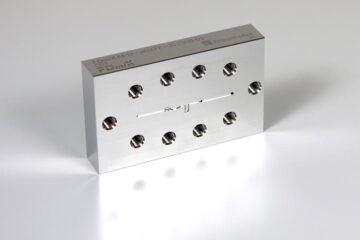Powerful radiation source to further cancer research

Physicists will construct an ultra-high intensity THz beamline and attempt to destroy skin cancer cells specially grown in a new tissue culture facility. The experiments will help scientists understand how to use this technology in future treatments for the disease in humans.
The THz beamline, funded by the Northwest Regional Development Agency (NWDA) through its North West Science Fund, will be developed using the prototype Fourth Generation Light Source (4GLS) being constructed at CCLRC Daresbury Laboratory, which will be used to develop light sources used in X-ray technology, laser studies and radiation sources.
Physicist, Professor Peter Weightman, said: “The prototype 4GLS facility is based on an Energy Recovery Linear accelerator. The energy produced by firing electrons around this accelerator will partly be used to power the THz beamline, which will link up to a tissue culture facility developed with scientists at the University of Nottingham.
“The culture facility will be used to grow skin cancer cells and the THz radiation will target the source of the cancer. THz is absorbed by water and cancer cells retain water, so the THz radiation should be consumed by the cell and kill it off at the source.”
Terahertz radiation has also been used in the detection of concealed weapons, explosives and drugs as it has the ability to penetrate a variety of materials such as clothing, paper, cardboard, wood, masonry, plastics and ceramics. THz can also pick up on vibrations and rotations of molecules and has been useful in identifying molecules floating in space.
The team at Liverpool hope to develop these applications using the most powerful source of broad band terahertz available in Europe – a thousand times more powerful than current laboratory sources.
This will be the first time THz technology has been used on cancer cells and it will also be developed to characterise genetic material. THz has the capability of identifying mutations in DNA, which could help medics identify pharmaceutical therapies that will be compatible with individual patients' DNA information.
Dr George Baxter, NWDA Director of Science and Innovation, said: “The NWDA is delighted to support this innovative project that will help develop new technology for the treatment of cancer. Investment in this project forms part of the NWDA's commitment to build and sustain a knowledge based economy for England's North West.”
Media Contact
More Information:
http://www.liv.ac.ukAll latest news from the category: Medical Engineering
The development of medical equipment, products and technical procedures is characterized by high research and development costs in a variety of fields related to the study of human medicine.
innovations-report provides informative and stimulating reports and articles on topics ranging from imaging processes, cell and tissue techniques, optical techniques, implants, orthopedic aids, clinical and medical office equipment, dialysis systems and x-ray/radiation monitoring devices to endoscopy, ultrasound, surgical techniques, and dental materials.
Newest articles

For microscopic organisms, ocean currents act as ‘expressway’ to deeper depths
New research shows how tiny plant-like organisms hitch a ride on ocean currents to reach darker and deeper depths, where they impact carbon cycling and microbial dynamics in the subtropical…

FDmiX: Fast, robust series production of nanoparticles
Nucleic acid-based medications such as mRNA vaccines are opening up new therapeutic approaches. These active ingredients must be enclosed inside nanoparticles to ensure that they get to where they are…

Sensor measures oxygen content of breath
Oxygen saturation in the blood that is either too low or too high can cause physical harm or even death. This is why patients’ oxygen concentraions are monitored continuously in…





















